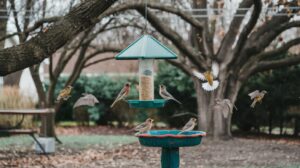As an avid outdoors enthusiast, you have likely often paused on a hike or walk to identify the birds singing in the trees and bushes around you. While visually identifying birds poses challenges, identifying them by sound may seem an even more daunting task. However, with some knowledge of the most common bird songs and calls in your area, and a little practice listening for key characteristics, you’ll be surprised by how many birds you can learn to identify by ear. This guide provides tips on learning to recognize the songs and calls of common backyard and woodland birds, as well as resources to build your skills as you embark on the rewarding journey of identifying birds by sound. Equipped with the knowledge in the following pages, you’ll soon find yourself picking out the songs of cardinals, chickadees and wrens as you appreciatively walk through your neighborhood or a park.
Why Identify Bird Sounds?
Improve Your Birdwatching Experience
Being able to identify birds by sound enhances your birdwatching experience and allows you to detect more species. Many birds are heard more often than seen, especially those that inhabit dense vegetation. Recognizing bird vocalizations provides more opportunities to detect and observe birds.
Gain a Deeper Appreciation of Birds
Learning bird sounds cultivates a deeper understanding and appreciation of birds. Each species has a distinct set of calls and songs used for communication, defending territories, attracting mates, and maintaining social bonds. Identifying these sounds provides insight into the complex social behaviors and interactions of birds.
Help with Bird Conservation
Recognizing bird vocalizations aids in bird population monitoring and conservation. Many wildlife surveys rely on detecting birds by sound to determine population numbers and distribution. Citizen science projects also use bird sounds to gather important data on bird populations over large geographic areas. By identifying bird sounds, you can contribute to these efforts and help inform bird conservation initiatives.
Enhance Your Connection to Nature
Identifying bird sounds helps foster a stronger connection to nature. The songs and calls of birds are an integral part of the natural soundscape. Becoming attuned to the vocalizations in your local environment awakens your senses and helps you become more aware of the daily rhythms and cycles of the natural world. Over time, the sounds of birds can become familiar and comforting, signaling the changing of the seasons and arrival of spring.
How to Recognize Common Bird Songs
To identify birds by sound, you must train your ear to recognize elements of their songs and calls. Focus on the pitch, pattern, rhythm, and tone to determine the bird species.
Learn Pitch
The pitch refers to the highness or lowness of the sound. Pay attention to whether the song ascends or descends in pitch. For example, the song sparrow has a descending trill, while the house sparrow has a flat, unmusical chirp.
Notice the Pattern
The pattern refers to the sequence and repetition of notes. Many birds have a signature pattern to their song. The northern cardinal, for instance, sings “whit-weet, whit-woo, whit-weet” in a very distinctive pattern. The chickadee, on the other hand, sings “chick-a-dee-dee-dee” in an repetitive, unchanging pattern.
Determine the Rhythm
The rhythm is the beat, tempo, and cadence of the song. Some birds have a hurried, energetic rhythm, while others are slow and melodic. Pay attention to the pace and beat. The wood thrush, for example, has a rhythmic “ee-oh-lay” song with a steady tempo, whereas the tufted titmouse has a quick “peter-peter-peter” song.
Analyze the Tone
The tone refers to the overall pitch, quality, and resonance of the sound. Some birds have a musical, flutelike tone, while others are harsh, grating, or mechanical. The hermit thrush has a hauntingly beautiful, melodic tone, while the blue jay has a loud, screeching tone.
With practice, you’ll be able to instantly recognize the songs and calls of common birds in your area. So get outside, listen up, and happy birding!
Identifying Bird Alarm Calls and Warning Sounds
Birds use a variety of sounds to communicate. Alarm calls are loud, abrupt vocalizations birds make when they perceive danger or feel threatened. Recognizing these warning sounds can help birdwatchers locate birds more easily and gain a better understanding of avian behavior.
Distress Calls
Birds emit distress calls when they are trapped, injured or captured by predators. The calls are harsh, high-pitched and repetitive. For example, a captured songbird may scream repeatedly in hopes of scaring off the predator or attracting the attention of other birds. Listen for a series of short, loud shrieks to identify a distress call.
Mobbing Calls
Mobbing calls are used to harass predators and involve a group of birds emitting a variety of loud sounds while flying around or mobbing the predator. The calls are meant to distract or intimidate the predator in defense of a nest or territory. Mobbing calls are particularly common during the breeding season. The sounds are varied but often include loud chirping, squawking and harsh shrieks.
Alarm Calls
Birds use alarm calls to warn others about the presence of predators or dangers in the area. The calls are short, abrupt and often high-pitched. For example, a bird may emit a loud “keeyah!” to signal a predator flying overhead. Other birds will then take cover in response. Some species have different calls for aerial versus terrestrial predators. Learning to recognize the specific alarm calls in your area can provide useful information about nearby wildlife activity.
By listening for distress calls, mobbing behavior and a variety of abrupt alarm vocalizations, birders can hone their sound identification skills. Recognizing these warning sounds provides insight into how birds perceive and respond to threats in their environment. With regular practice, birders will be able to identify many avian alarm calls and understand the level of urgency being conveyed.
Useful Tools and Resources for Bird Sound Identification
Field Guides and Reference Books
Field guides and reference books focusing on bird sounds and songs can be extremely helpful for identifying unknown vocalizations. Some recommended guides include the Stokes Field Guide to Bird Songs, the Peterson Field Guide to Bird Sounds of Eastern North America, and the Kaufman Field Guide to Bird Songs of North America. These provide written descriptions of songs and calls, sonograms or spectrograms to illustrate the sounds visually, and in some cases, audio samples that can be accessed via a companion website or mobile app.
Online Resources
There are many free, online resources for learning bird sounds. The Cornell Lab of Ornithology’s All About Birds website provides a large collection of bird songs and calls with recordings, sonograms, and descriptions. The Audubon Bird Guide app offers a similar collection of audio clips that can be accessed in the field. Other useful sites include Audubon.org, NationalGeographic.com, and BirdsOfNorthAmerica.net.
Recording and Playback Devices
For active bird sound identification in the field, recording and playback equipment can be very effective. A small digital recorder or parabolic microphone can capture vocalizations to review later or analyze using sonogram software. Playback devices that can broadcast recorded or downloaded songs and calls are also useful for eliciting responses from birds to aid in identification. Some popular, easy-to-use products for beginners include the Tascam DR-05 Digital Audio Recorder and the BirdJammer Digital Bird Call Playback System.
Sonogram Software
Sonogram or spectrogram software allows you to visualize bird vocalizations as sound waveforms. This can make identification much easier by providing a visual representation of the song or call. Free, downloadable sonogram software options include Audacity, Praat, and Raven Lite. Smartphone apps like Song Sleuth and Merlin Bird ID can also generate sonograms in the field to help determine what bird is singing. Analyzing sonograms, in combination with listening to recordings, is one of the best ways to develop a trained ear for bird sounds.
With practice and the aid of these useful tools, you’ll be identifying bird songs and calls in no time. The key is exposing yourself to as many vocalizations as possible by regularly listening to and analyzing recordings, both at home and out in nature. Your birding experience will be greatly enriched once you’ve mastered this challenging but rewarding skill.

Bird Sounds Identification FAQs: Your Top Questions Answered
How can I identify birds by their songs and calls?
To identify birds by sound, start by listening for distinct characteristics like tempo, pitch, pattern, and quality. Songs are usually complex vocalizations used by male birds during the breeding season to establish territories and attract mates. Calls are simpler vocalizations used for communication year-round. Pay attention to the time of day and year you hear the sounds, as this can help determine the species. With practice, you’ll get better at identifying subtle differences.
What resources can I use to help me learn?
Several resources can help you identify bird sounds. Field guides often include audio clips to compare the songs and calls of different species in your area. Free websites and mobile apps like Audubon Bird Guide, Merlin Bird ID, and Larkwire provide recordings, photos, and information to help you learn. Some also use AI to provide suggestions based on your location and the sounds you describe.
How long does it take to become proficient?
Becoming highly proficient at identifying bird sounds takes a significant time commitment and consistent practice. Expect it to take at least a year of regular listening and study to become reasonably adept, and many years of experience to become an expert. The key is to start with common birds in your local area, learn to recognize their most distinctive sounds, then gradually progress to more subtle differences between similar species.
With regular listening and the help of useful resources, you’ll be well on your way to becoming fluent in the language of birds. Staying patient and maintaining realistic expectations will serve you well. While it may seem an insurmountable task at first, stick with it and you’ll gain a skill that provides a lifetime of rewards.
Conclusion
Through mindful listening and diligent study, you can train your ear to identify bird sounds. Start by learning the songs of common backyard birds. Then venture to new habitats and environments to expand your repertoire. With practice, patience, and an openness to learn, you will soon delight in your newfound ability to recognize the melodies of chickadees and finches, the trills of warblers, and the raucous calls of jays and crows. The more attentive you become, the more you will appreciate the beauty and complexity of avian vocalizations all around you. Mastering these skills takes time, but the rewards are immense. So open your ears, engage all your senses, and let the wondrous world of birdsong enrich your life.
Don’t Miss a Thing! Enhance Your Wildlife Photography with Ultra-X Night Vision Goggles.
GET NOW!






